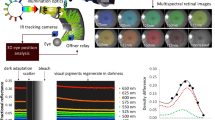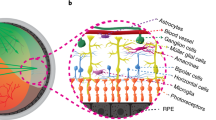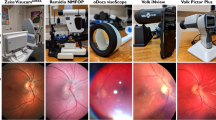Abstract
Enabled by adaptive optics, retinal photoreceptor cell imaging is changing our understanding of retinal structure1,2 and function3,4, as well as the pathogenesis of numerous ocular diseases5. To date, use of this technology has been limited to cooperative adult subjects due to the size, weight and inconvenience of the equipment, thus excluding study of retinal maturation during human development. Here, we report the design and operation of a handheld probe that can perform both scanning laser ophthalmoscopy and optical coherence tomography of the parafoveal photoreceptor structure in infants and children without the need for adaptive optics. The probe, featuring a compact optical design weighing only 94 g, was able to quantify packing densities of parafoveal cone photoreceptors and visualize cross-sectional photoreceptor substructure in children with ages ranging from 14 months to 12 years. The probe will benefit paediatric research by improving the understanding of retinal development, maldevelopment and early onset of disease during human growth.
This is a preview of subscription content, access via your institution
Access options
Subscribe to this journal
Receive 12 print issues and online access
$209.00 per year
only $17.42 per issue
Buy this article
- Purchase on Springer Link
- Instant access to full article PDF
Prices may be subject to local taxes which are calculated during checkout




Similar content being viewed by others
References
Roorda, A. & Williams, D. R. The arrangement of the three cone classes in the living human eye. Nature 397, 520–522 (1999).
Shemonski, N. D. et al. Computational high-resolution optical imaging of the living human retina. Nature Photon. 9, 440–443 (2015).
Rossi, E. A. & Roorda, A. The relationship between visual resolution and cone spacing in the human fovea. Nature Neurosci. 13, 156–157 (2010).
Sincich, L. C., Zhang, Y., Tiruveedhula, P., Horton, J. C. & Roorda, A. Resolving single cone inputs to visual receptive fields. Nature Neurosci. 12, 967–969 (2009).
Zacharria, M., Lamory, B. & Chateau, N. Biomedical imaging new view of the eye. Nature Photon. 5, 24–26 (2011).
Sheehy, C. K. et al. High-speed, image-based eye tracking with a scanning laser ophthalmoscope. Biomed. Opt. Express 3, 2611–2622 (2012).
Roorda, A. & Williams, D. R. Optical fiber properties of individual human cones. J. Vis. 2, 404–412 (2002).
Liu, Z., Kocaoglu, O. P., Turner, T. L. & Miller, D. T. Modal content of living human cone photoreceptors. Biomed. Opt. Express 6, 3378–3404 (2015).
Duncan, J. L. et al. High-resolution imaging with adaptive optics in patients with inherited retinal degeneration. Invest. Ophthalmol. Vis. Sci. 48, 3283–3291 (2007).
Hendrickson, A., Possin, D., Vajzovic, L. & Toth, C. A. Histologic development of the human fovea from midgestation to maturity. Am. J. Ophthalmol. 154, 767–778 (2012).
Prakalapakorn, S. G., Wallace, D. K. & Freedman, S. F. Retinal imaging in premature infants using the Pictor noncontact digital camera. J. Am. Assoc. Pediatr. Ophthalmol. Strabismus 18, 321–326 (2014).
Kelly, J. P., Weiss, A. H., Zhou, Q., Schmode, S. & Dreher, A. W. Imaging a child's fundus without dilation using a handheld confocal scanning laser ophthalmoscope. Arch. Ophthalmol. 121, 391–396 (2003).
Scott, A. W., Farsiu, S., Enyedi, L. B., Wallace, D. K. & Toth, C. A. Imaging the infant retina with a hand-held spectral-domain optical coherence tomography device. Am. J. Ophthalmol. 147, 364–373 (2009).
Woonggyu, J. et al. Handheld optical coherence tomography scanner for primary care diagnostics. IEEE Trans. Biomed. Eng. 58, 741–744 (2011).
Lu, C. D. et al. Handheld ultrahigh speed swept source optical coherence tomography instrument using a MEMS scanning mirror. Biomed. Opt. Express 5, 293–311 (2014).
Roorda, A. et al. Adaptive optics scanning laser ophthalmoscopy. Opt. Express 10, 405–412 (2002).
Dubra, A. et al. Noninvasive imaging of the human rod photoreceptor mosaic using a confocal adaptive optics scanning ophthalmoscope. Biomed. Opt. Express 2, 1864–1876 (2011).
Potsaid, B. et al. Ultrahigh speed spectral/ Fourier domain OCT ophthalmic imaging at 70,000 to 312,500 axial scans per second. Opt. Express 16, 15149–15169 (2008).
Schmoll, T., Kolbitsch, C. & Leitgeb, R. A. Ultra-high-speed volumetric tomography of human retinal blood flow. Opt. Express 17, 4166–4176 (2009).
Potsaid, B. et al. Ultrahigh speed 1050 nm swept source/Fourier domain OCT retinal and anterior segment imaging at 100,000 to 400,000 axial scans per second. Opt. Express 18, 20029–20048 (2010).
LaRocca, F., Dhalla, A. H., Kelly, M. P., Farsiu, S. & Izatt, J. A. Optimization of confocal scanning laser ophthalmoscope design. J. Biomed. Opt 18, 076015 (2013).
LaRocca, F., Nankivil, D., Farsiu, S. & Izatt, J. A. Handheld simultaneous scanning laser ophthalmoscopy and optical coherence tomography system. Biomed. Opt. Express 4, 2307–2321 (2013).
LaRocca, F., Nankivil, D., Farsiu, S. & Izatt, J. A. True color scanning laser ophthalmoscopy and optical coherence tomography handheld probe. Biomed. Opt. Express 5, 3204–3216 (2014).
Donnelly Iii, W. J. & Roorda, A. Optimal pupil size in the human eye for axial resolution. J. Opt. Soc. Am. A 20, 2010–2015 (2003).
Goncharov, A. V. & Dainty, C. Wide-field schematic eye models with gradient-index lens. J. Opt. Soc. Am. 24, 2157–2174 (2007).
Curcio, C. A., Sloan, K. R., Kalina, R. E. & Hendrickson, A. E. Human photoreceptor topography. J. Comp. Neurol. 292, 497–523 (1990).
Chui, T. Y. P., Song, H. & Burns, S. A. Individual variations in human cone photoreceptor packing density variations with refractive error. Invest. Ophthalmol. Vis. Sci. 49, 4679–4687 (2008).
Staurenghi, G., Sadda, S., Chakravarthy, U. & Spaide, R. F. Proposed lexicon for anatomic landmarks in normal posterior segment spectral-domain optical coherence tomography the IN•OCT consensus. Ophthalmology 121, 1572–1578 (2014).
Yuodelis, C. & Hendrickson, A. A qualitative and quantitative analysis of the human fovea during development. Vision Res. 26, 847–855 (1986).
American National Standard Institute (ANSI). American National Standard for the Safe Use of Lasers (2000).
Cooper, R. F., Langlo, C. S., Dubra, A. & Carroll, J. Automatic detection of modal spacing (Yellott's ring) in adaptive optics scanning light ophthalmoscope images. Ophthalmic Physiol. Opt. 33, 540–549 (2013).
Gordon, R. A. & Donzis, P. B. Refractive development of the human eye. Arch. Ophthalmol. 103, 785–789 (1985).
Augusteyn, R. C. et al. Human ocular biometry. Exp. Eye Res. 102, 70–75 (2012).
Atchison, D. A. et al. Eye shape in emmetropia and myopia. Invest. Ophthalmol. Vis. Sci. 45, 3380–3386 (2004).
Chavala, S. H. et al. Insights into advanced retinopathy of prematurity using handheld spectral domain optical coherence tomography imaging. Ophthalmology 116, 2448–2456.
Acknowledgements
The authors thank L. Vajzovic, S. Freedman, D. Tran-Viet, S. Mangalesh and A. Dandridge (Duke University Medical Center) for their assistance with enrolling research participants and with acquiring clinical research data. The authors also thank C. Viehland and B. Keller (Duke University) for developing the software used to render the volumetric OCT data. This research was supported in part by grants from the National Institutes of Health (R21-EY02132 and R01-EY023039) and the Hartwell Foundation. D.N. was funded in part by the Fitzpatrick Foundation Scholarship.
Author information
Authors and Affiliations
Contributions
F.L. designed and constructed the optical system, collected data, analysed data and drafted the manuscript. D.N. developed the mechanical design and edited the manuscript. T.D. contributed the theoretical and mathematical basis for the novel compact telescope design. C.A.T., S.F. and J.A.I. provided overall guidance to the project, reviewed and edited the manuscript, and obtained funding to support this research. This work was carried out entirely at Duke University from May 2014 to April 2016 without consultation or influence by Johnson & Johnson Vision Care Inc. As of June 2016, D.N. is employed by Johnson & Johnson Vision Care Inc.
Corresponding author
Ethics declarations
Competing interests
During part of this work, J.A.I. was Chairman and Chief Scientific Advisor at Bioptigen and had corporate, equity and intellectual property interests (including royalties) in this company. F.L., D.N., T.D. and J.A.I. are inventors on a patent application assigned to Duke University related to this work. Other authors declare no competing financial interests.
Supplementary information
Supplementary information
Supplementary information (PDF 1735 kb)
Rights and permissions
About this article
Cite this article
LaRocca, F., Nankivil, D., DuBose, T. et al. In vivo cellular-resolution retinal imaging in infants and children using an ultracompact handheld probe. Nature Photon 10, 580–584 (2016). https://doi.org/10.1038/nphoton.2016.141
Received:
Accepted:
Published:
Issue Date:
DOI: https://doi.org/10.1038/nphoton.2016.141
This article is cited by
-
Contactless optical coherence tomography of the eyes of freestanding individuals with a robotic scanner
Nature Biomedical Engineering (2021)
-
Super-resolution retinal imaging using optically reassigned scanning laser ophthalmoscopy
Nature Photonics (2019)



